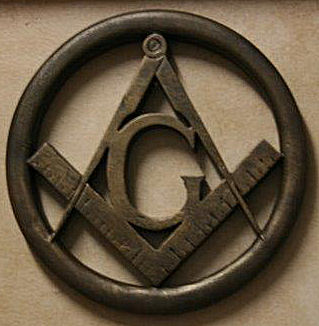The "Square & Compasses"
Masonic Plaque

This is an original Masonic
Plaque created by MARBLECast® Products, Inc. depicting two of the
most important symbols in Freemasonry... the
Square and Compasses. The Square is one of the most important and
significant symbols in Freemasonry. As such, it is proper that its true form
should be preserved. French Freemasons have almost universally given it with
one leg longer than the other (like the one pictured above) thus
making it a carpenter's square. American Freemasons, following the incorrect
delineations of Brother Jeremy L. Cross, have, while generally preserving the
equality of length in the legs, unnecessarily marked its surface with inches;
thus making it an instrument for measuring length and breadth, which it is
not. It is simply the trying square of a stone-mason, and has a
plain surface; the sides or legs embracing an angle of ninety degrees, and is
intended only to test the accuracy of the sides of a stone, and to see that
its edges subtend the same angle. In Freemasonry, the square is a symbol of
morality. This is its general signification, and applied in various ways:
1. It presents itself to the neophyte as one of the Three Great Lights. 2.
To the Fellow Craft as one of his Working-tools. 3. To the Master Mason as
the official emblem of the Master of the Lodge. Everywhere, however, it
inculcates the same lesson of morality, of truthfulness, of honesty. So
universally accepted is this symbolism, that it has gone outside of the Order,
and has been found in colloquial language communicating the same idea. The
Square, says Halliwell, Dictionary of Archaic and Provincial Words,
means honest, equitable, as in "square dealing." To play upon
the square is proverbial for to play honestly. In this sense
the word is found in the old writers. As a Masonic symbol, it is of very
ancient date, and was familiar to the Operative Masons. In the year 1830,
the architect, in rebuilding a very ancient bridge called Baal Bridge, near
Limerick, in Ireland, found under the foundation-stone an old brass square,
much eaten away, containing on its two side surfaces the following
inscription, the U being read as V: I. WILL STRIUE. TO. LIUE.--WITH. LOUE. &
CARE.--UPON. THE LEUL.--BY. THE. SQUARE., and the date 1517. The modern
Speculative Freemason will recognize the idea of living on the level and
by the square. This discovery proves, if proof were necessary, that the
familiar idea was borrowed from our Operative Brethren of former days. The
square, as a symbol in Speculative Freemasonry, has therefore presented itself
from the very beginning of the revival period. In the very earliest catechism
of the eighteenth century, of the date of 1725, we find the answer to the
question, "How many make a Lodge?" is "God and the Square, with five or seven
right or perfect Masons." God and the Square, religion and morality, must be
present in every Lodge as governing principles. Signs at the early period
were to be made by squares, and the Furniture of the Lodge was
declared to be the Bible, Compasses, and Square. In all rites and in all
languages where Freemasonry has penetrated, the square has preserved its
primitive signification as a symbol of morality.
As in Operative Freemasonry, the compasses
are used for the admeasurements of the architect's plans, and to enable him to
give those just proportions which will ensure beauty as well as stability to
his work; so, in Speculative Freemasonry, is this important implement symbolic
of that even tenor of deportment, that true standard of rectitude which alone
can bestow happiness here and felicity hereafter. Hence are the compasses the
most prominent emblem of virtue, the true and only measure of a Freemason's
life and conduct. As the Bible gives us Light on our duties
to God, and the square illustrates our duties to our neighborhood and
Brother, so the compasses give that additional light which
is to instruct us in the duty we owe to ourselves--the great, imperative duty
of circumscribing our passions, and keeping our desires within due bounds.
"It is ordained," says the philosophic Burke, "in the eternal constitution of
things, that men of intemperate passions cannot be free; their passions forge
their fetters." Those Brethren who delight to trace our emblems to an
astronomical origin, find in the compasses a symbol of the sun, the
circular pivot representing the body of the luminary, and the diverging legs
his rays. In the earliest rituals of the eighteenth century, the
compasses are described as a part of the furniture of the Lodge, and are
said to belong to the Master. Some change will be found in this respect in
the ritual of the present day. The word is sometimes spelled and pronounced
compass, which is more usually applied to the magnetic needle and
circular dial or card of the mariner from which he directs his course over the
seas, or the similar guide of the airman when seeking his destination across
unknown territory.
Made of marble material, this beautifully sculpted
original measures approx. 8 inches in diameter by approx 3/4 inches deep.
It is available now for $30.00 plus $5.00 shipping/handling (within the
48 contiguous United States).
To order:
Please make all checks or money orders payable to:
MarbleCast Products, 947 Folsom Avenue West, Salt Lake City, Utah 84104. To pay by credit card we accept PayPal payments to: mrc@statues.com
Utah residents add 5.95% state sales tax. Please allow 3-4 weeks for delivery.
We ship via FedEx so include your physical address. No P.O. Boxes
please!

